Presidents: James Buchanan
Birthplace and Boyhood Home, Mercersburg, Pennsylvania
Visited most recently in 2013.
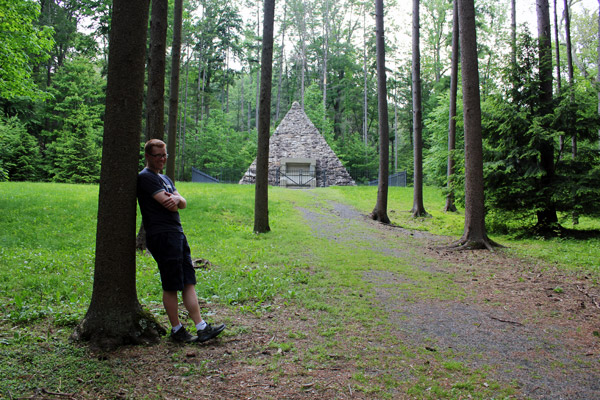
Cove Gap: The humble origins of the (maybe) worst president.
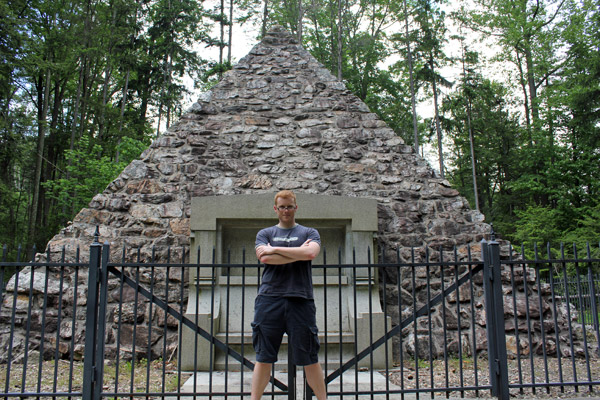
Cove Gap: The secrets of the pyramids revealed.
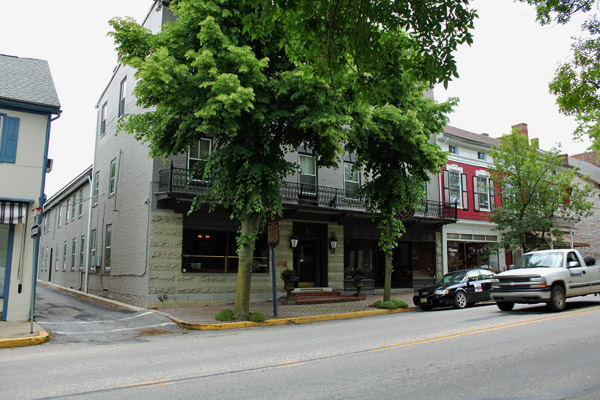
Mercersburg: The site of ye olde boyhood home. Now a restaurant!
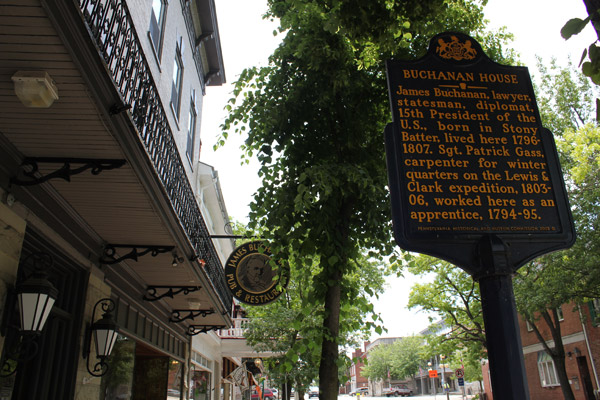
Mercersburg: The site of ye olde boyhood home. Now a restaurant!
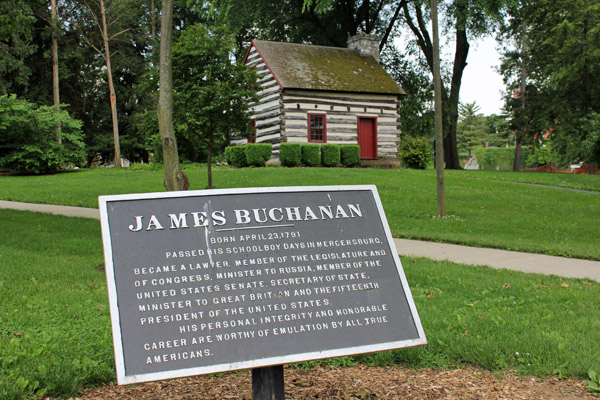
The alleged birth cabin, on the grounds of Mercersburg Academy.
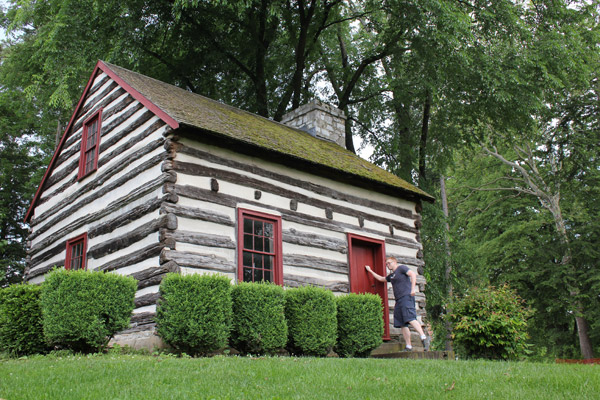
Mercersburg: Nobody was home. Sigh.
Consider the legend of America's greatest president, contrasted with the story of the man considered the worst. Abraham Lincoln was born in a log cabin in the wilderness, had some mildly adventurous formative years, trained as a lawyer, and ended up president of a fractured nation. James Buchanan was born in a log cabin in the wilderness, had some mildly adventurous formative years, trained as a lawyer, and ended up president of a fractured nation. And Buchanan did it first.
History is hilarious, and if more people got the joke, Mercersburg would be raking in the tourist dollars. For now the lines at the Buchanan historic sites are manageable. You can roll up to the James Buchanan Pub and Restaurant at 2 p.m. on a Thursday, and (get this) it won't even be open!
Which is understandable. There's not much going on in south central Pennsylvania these days. Mercersburg is surrounded by sleepy farm country, and major highways don't take you through the town. There's a famous school there -- Mercersburg Academy was actually the alma mater of Jimmy Stewart, and Harvey the invisible rabbit -- but it's not a thriving metropolis.
In 1791, it was a different story. The wagon road ran straight through the town, which was a significant outpost on the journey west -- at a time when everything to the left of Pittsburgh on a map had pictures of dragons. James Buchanan Sr. had a trading outpost at a spot he called Stony Batter, where people could stock up on the supplies they would need to fight Indians, feed their horses or satisfy their urges for 18th-century erotica. There might have been Slim Jims, too.
Buchanan was born at Stony Batter, a few miles from Mercersburg, in some kind of log cabin. No one realized he would be famous, so they didn't bother marking which cabin was the sacred one. Today, a cabin from Stony Batter has been transported to the grounds of Mercersburg Academy, where many generations of prep students have spied it from the lacrosse field and asked, "what the **** is that?" Some have even gotten to second base while leaning up against it. It might be Buchanan's birthplace, but it also might have been a storage shed for the 18th-century equivalents of glow-in-the-dark condoms, impotence cures and Twinkies. Either way, it's a fine and historically valuable structure, and if you want you can drive straight on to campus and stare at it for a few minutes -- no charge.
Stony Batter itself is now the home of a state park and a small pyramid that marks the alleged site of the birth cabin. The cash to set it up came from Harriet Lane, Buchanan's niece; as he had no children or wife, she was the sole protector of his legacy -- a fun job, whereby she had to convince people that her uncle was not the worst president who ever lived. When she died in 1903, she left behind the funds to set up both the birthplace marker and a statue in Meridian Hill Park in Washington. Meridian Hill Park for a time became Malcolm X Park, and it was an open air drug market during the crack epidemic, so a stone Buchanan probably oversaw all kinds of stabbings and compensatory sex acts. Just like the good old days.
The Buchanans moved by 1796, heading a few miles south to the civilized confines of Mercersburg. The roads there were probably still dirt -- but a more orderly kind of dirt. James would spend the next 10 or so years there, before shipping off to Dickinson College and a life of adventure; he would be a state and federal legislator, an ambassador and the secretary of state before Democrats finally decided it was his turn to run the country. It all worked out great, except for the start of the Civil War.
The aforementioned Pub and Restaurant is in the building where the Buchanans lived in Mercersburg, so there's the tantalizing possibility of having a beer in the very place that 10-year-old James Buchanan has his first beer. You just have to get there between 5 p.m. and 9 p.m. on a Friday or Saturday. All other times, the restaurant honors Buchanan's legacy by doing nothing, while frustrations mount among the throngs of thirsty history nerds on the sidewalk.
OK, it was just me. But I'm a one-man throng.
Lancaster, Pennsylvania
Visited in 2006, 2010 and 2016.
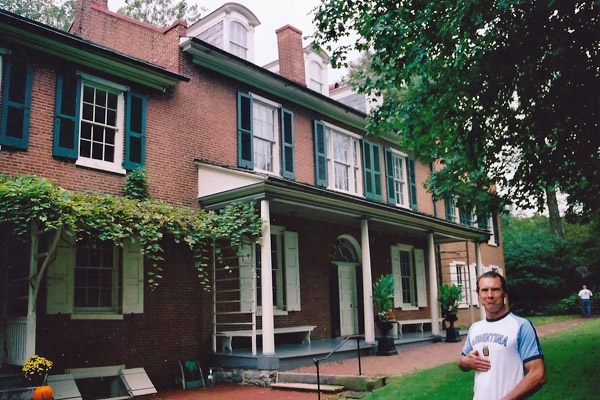
Wheatland. Not pictured: all that delicious wheat.
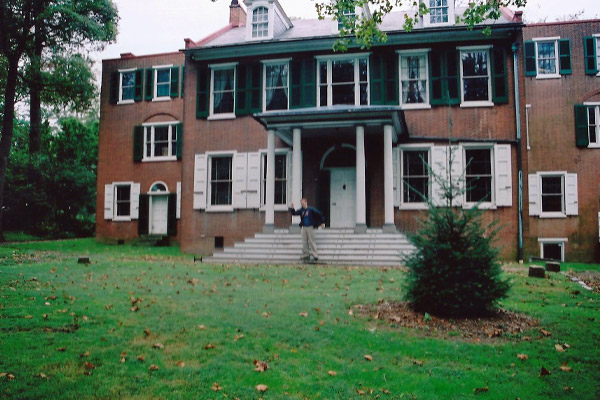
The mullet of houses! Northern in the front, southern in the back.
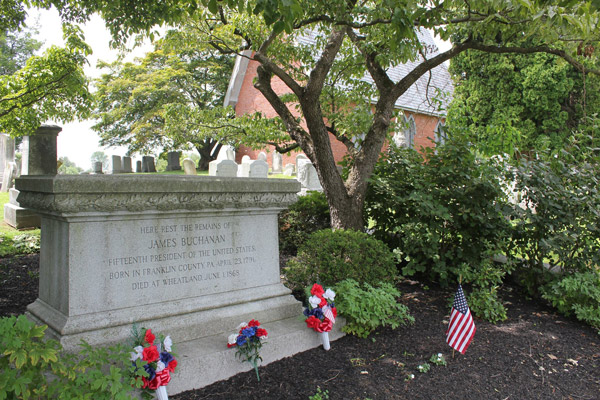
Woodward Hill: A beaten down cemetery for a beaten down president.
From Amish Country lawyer to leader of the free world: This is the glorious legacy of James Buchanan, Pennsylvania's only president! Yes, you can see it all at Wheatland, the swank Lancaster estate of J.B. from 1848-1868. And who was James Buchanan?
He was the oldest of 11 children of an Irish immigrant. He was a highly successful lawyer, a Pennsylvania House member, a U.S. representative, ambassador to Russia, a U.S. senator, secretary of State, ambassador to England and possibly the worst ever president of these United States.
And oh yeah, he was FABULOUS (i.e. gay), according to some people. The pamphlet they were handing out at the mansion in 2006 said he "was our nation's only bachelor president." The emphasis is theirs, which is a polite way of saying, "stop asking if he was gay." Here's the story they tell at Wheatland:
In 1819 he gets engaged to Ann Coleman, the daughter of a very rich guy from Philadelphia (our country's first millionaire, as he came from old-world cheese steak money). J.B. supposedly gets so wrapped up in a law case that she feels neglected -- which by 1819 standards means that he didn't touch her gloved hand while avoiding eye contact more than once a month. She starts talking smack ALL OVER the two blocks of downtown Lancaster, thereby fronting J.B. and driving a wedge between them. Even the Amish were mocking him, and once the Amish start talking about you, you're dead in this town. Then, on a trip to Philadelphia, she dies suddenly. Buchanan is so heartbroken and bitter from the relationship that he never pursues love again.
Or that's what they'd have you believe. My fine docent in 2006 said Ann was a possible suicide, based on reports of two hysterical incidents before her death. The obvious truth: Buchanan's bachelor pal, motivated by jealousy, confronted and killed her with a pitchfork. I mean, duh.
James had at least one lady in his life, though: in 1842 he became the guardian of his orphaned niece, Harriet Lane. And also "Buck" Henry, his nephew who became his personal White House secretary before a falling out over Buck growing a mustache. But that's another story. Fun Harriet Lane facts:
- She was in charge of White House hostess duties, the usual job of the president's wife. She was the first person known as "First Lady," a title given even to the wives that followed her. The "Second Lady" was Melba, Harriet's fatter, uglier friend.
- She collected art, and on her death, donated her collection for the purpose of establishing a museum. That collection eventually became a foundation of the National Gallery of Art. Also on instructions from her will, her skeleton was preserved and placed in the jaws of the first T-Rex skeleton displayed at the Museum of Natural History.
- She ponied up the dough to found St. Alban's prep school in D.C., where Al Gore went to school. So, HARRIET LANE BANKROLLED THE INTERNET.
As for the Buck thing, I wasn't kidding. Which is sad, because if your name is Buck, you almost have to grow a mustache.
But back to Buchanan! He is an absolutely fascinating public figure, and you could make the case that at the time of his election he was the most qualified president in the history of the United States. He was a student of the political game, and his home state was a fulcrum for policy battles that split the North and South. Buchanan, as an operator of Pennsylvania's political machine, managed to stay releveant for decades. His nomination in 1856 was a triumph he had worked toward his entire adult life. As the nation moved relentlessly toward a schism, the "man in the middle" was the only truly viable candidate for the Democrats.
But circumstance, and Buchanan's personal shortcomings, made his presidency a bit of a disaster. He was one for calcualted compromise, but the nation was too far gone by the time he took office. His presidency was basically him sitting on his hands as Southern states progressed toward secession. When it finally happened, he felt he couldn't legally stop them from this illegal act. And beyond that, the Democratic party he was leading was a disorganized shambles. James Buchanan became the presidential equivalent of that lady in your office who has been there for 13 years. No one knows exactly what she does, but she has set up shop in middle management, and now she hangs around in the kitchenette a lot and always talks about how the people in charge are totally running the company into the ground and it used to be so much better when she started. When you ask her why she doesn't do anything about it she says it's not her job and then goes to reorganize the pictures of cats in her cubicle. That's Buchanan exactly.
He actually ran the 1856 campaign from Wheatland, and he gave a few speeches from the porch, including his famous "Look, He's Just a Guy That I Like to Discuss Farming With And On Occasion We Take a Steam And So What If He Owns a Pitchfork Making Company" Address. Also, while in the White House, he received the first ever trans-Atlantic telegram. So that's a thing, if you're a telegram enthusiast.
His home at Wheatland is exceedingly tasteful. Buchanan purchased the property later in life, and he sought a home befitting his status as Lancaster's leading citizen. It was built for both comfortable living and entertaining. (Buchanan was known for drinking a LOT of alcohol but still staying lucid.) Case in point: Wheatland has a privy with not one, not two, not three, but FIVE seats in the same room. They were equipped for five people to pop a squat at the same time. And that's clearly where business got done in the 1850s. "Say, this card game is great fun, but what say you we go peel off our 35 layers of sweat-soaked, unlaundered britches and discuss states' rights on the can?" It was a classier era. I loved seeing Buchanan's first-floor study, which probably looks pretty close to the way it would have in Buchanan's day.
And I also loved the front porch, since I had the chance to shake my fist there as part of a mock "front porch campaign." One side of the house has a style similar to Southern homes of the era, while the other side has a more Northern feel. According to my guide, visiting politicos were brought to the side most appropriate to them. If that's true, it's a pretty amazing comment on the divided politics of the 1850s, and Pennsylvania's precarious position between the regions.
Buchanan spent his last years in Wheatland, getting his vast financial empire in order and trying to clear his good name. He wrote a brief memoir of his presidency that tried to pin the blame for the Civil War on the radical abolition movement. It's not an easy read.
And Buchanan is spending his current years in Woodward Hill Cemetery, not too far from Wheatland. It's an average grave, which is probably reflective of Buchanan's financial modesty and the "optics" of doing anything extravagant for the deeply unpopular ex-president just a few years after the Civil War. The grave has been defaced in recent generations, at least once with anti-gay slurs. Fortunately, it has been cleaned up after every slight. Woodward Hill is a little rough around the edges, but you still gotta pay your respects.
Old Soldiers Home / Quarters One, Washington, DC
Visited in 2013.
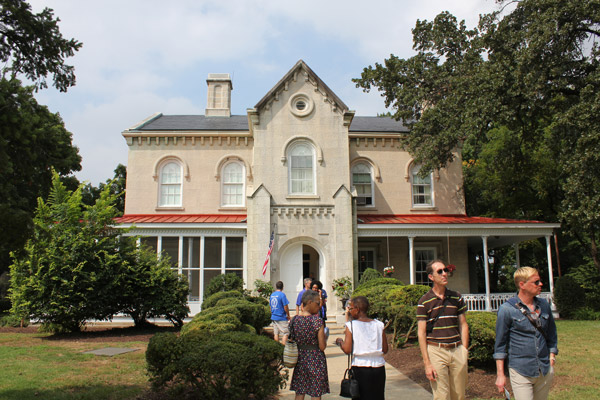
The sidewalk approach to Quarters One, the Air BnB of the presidents.
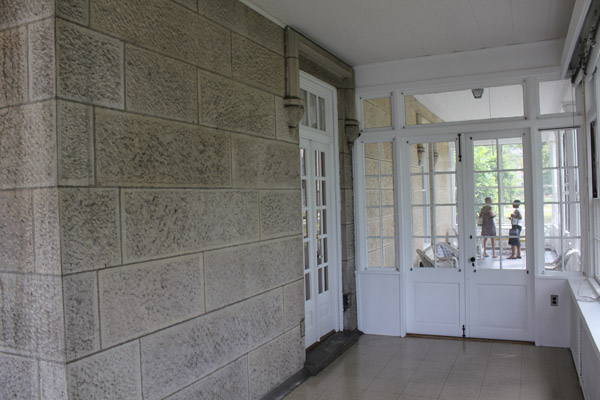
The back porch of Quarters One, where many a glass of brandy was chugged.
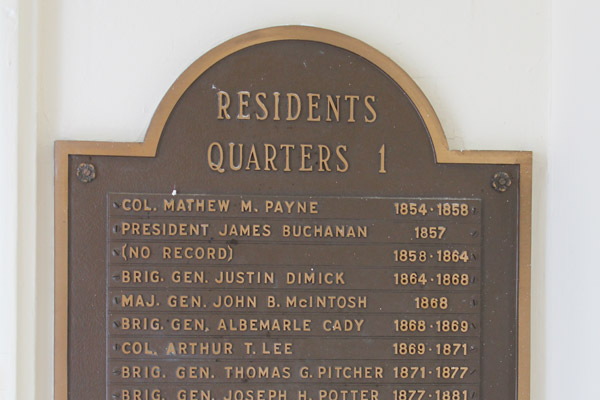
I saw the sign. Now you've seen it, too!
Winfield Scott started his career in the Army in 1808, so by the 1840s he was an old soldier. He thought about old soldiers' problems and wanted to solve them, but the government never seemed to have the cash to realize his vision. Scott, being a Type A personality, found another government that would.
During the Mexican-American War, Scott led his troops on an ass-kicking tour of our neighbor to the south. No group of Americans would abuse Mexico so thoroughly until Spring Break 1995. By the time he reached Mexico City, the Mexicans had no hope of victory or even a spirited defense; Scott astutely "negotiated" a $150,000 contribution from their leaders, and in exchange he graciously declined to burn their city to the ground. With a little bit of bureaucratic strong-arming, he kept that money in his own budget, and 1851 he used it to set up a nice little village for retired and disabled troops in Washington. They called it the Old Soldiers' Home. High atop a hill, it had views of the capital and nice breezes that would blow away the old guy smell.
Abraham Lincoln liked spending his summers there, since it was removed from the muggy shores of the Potomac and closer to some of the Union troops he was ordering into battle. He spent almost a quarter of his presidency as a resident of the Anderson Cottage (the main residence of the estate that was purchased to create the facility). It was there that he finalized the Emancipation Proclamation.
But when you focus on Lincoln, you miss out on the glorious depth of history on display at the Soldiers' Home. Sure, Lincoln crashed there. But so did Chester A. Arthur, and Rutherford B. Hayes. And who could forget the stunning residency of James Buchanan, who walked those hallowed grounds while thinking about ... uh, whatever James Buchanan actually did. His completely ineffective approach to the presidency might have allowed the Civil War to start, which allowed Lincoln to become famous, which gives you a reason to visit the Soldiers' Home today.
Sadly, there are few opportunities for most visitors to rejoice in James Buchanan. On the other hand, I'm not most visitors. As a member of the exclusive "Lincoln Cottage" e-mail list (which you can get on only by asking) I was informed over the the summer of a delightful event marking the opening of a new veterans' facility on the grounds; as part of the festivities, guests could walk around some of the structures that are usually closed to the public. I went up in the clock tower of the Sherman Building, which gives you a view clear down to the river. I tramped around some very exciting administrative offices with linoleum floors.
Best of all, I got to see Quarters 1. There are private residences on the grounds of the Soldiers' Home, which makes it the ultimate gated community -- not only do you have a fence, but you have government employees with assault rifles standing guard at the driveway. (Preference is given to people who work at the Home, so don't get your hopes up.) A few of those homes were damaged by a 2011 earthquake, and during the renovations they were emptied out. The "open house" for the whole campus came along just as the touch-up work was completed, so they let us snoop around.
As indicated by a very nice plaque at the entrance, Buchanan stayed at Quarters 1 in 1857, making him its second resident. There's nothing all that amazing about the home, and there was no real furniture in it when I visited. But hey, James Buchanan. Don't act like you aren't jealous.
